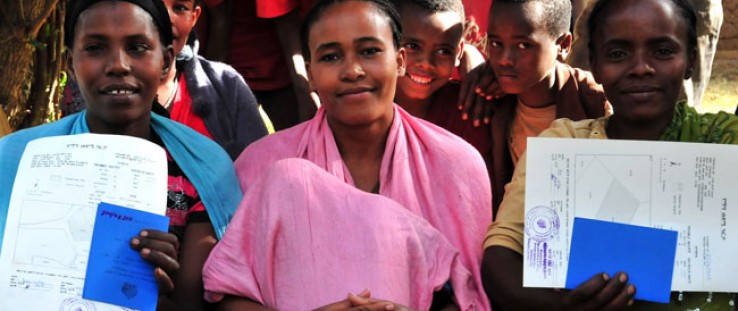 Three young women in Wendo Genet proudly display their land certificates.
Gregory Myers, USAID
Three young women in Wendo Genet proudly display their land certificates.
Gregory Myers, USAID
 Three young women in Wendo Genet proudly display their land certificates.
Gregory Myers, USAID
Three young women in Wendo Genet proudly display their land certificates.
Gregory Myers, USAID
Kimya Ahmed never imagined how a simple piece of paper would change her life. But that is exactly what happened after she and her husband received a formal certificate of land use from the government in 2004.
After converting from insecure occupants to secure rights-holders, the Ahmeds decided to further invest in the small patch of farm. In doing so, they increased the variety of crops they grew and improved their yields and income.
Similar stories have been playing out across Ethiopia ever since the government, with Agency support, began implementing a pilot land-certification scheme back in 2005 to promote property rights and to address serious problems of declining agricultural productivity, resource degradation and conflict over boundaries.
USAID Ethiopia: Strengthening Land and Property Rights
The rationale was simple: If people had more secure user rights to the land they worked, they would take better care of it. With more productive land, the country’s overall food and economic security would improve as well.
The Government of Ethiopia is the owner of all land in the country, and regional governments have primary authority over who gets to use the land. For decades, farmers living and working a plot had very little security and limited protection against either Imperial-era landlords or the Marxist government. They were conditioned by a long history of unequal land holdings, and susceptible to unforeseen land seizures and nationalization and repeated land redistribution.
These factors made life hard and unpredictable for poor smallholder farmers, who make up the majority of Ethiopia’s population. It also turned out to be devastating for the country’s agricultural productivity. Lack of security among millions of smallholder farmers was contributing to the misuse and overuse of land-based resources. A hostile social and legal environment meant farmers had few incentives to invest time or effort improving or conserving their land or in planting more lucrative perennial crops. With low yields, people were often hungry.
700,000 Land Parcels
A profound shift in land tenure arrangements began in 2002 when the government stopped redistributing land. This change created a window of opportunity. Starting in 2004, USAID officials worked with the Ethiopian Government to pilot a program to give landholders clear use rights in selected regions, including allowing them to lease the land to others for income.
“This was an experiment in Ethiopia but one that has worked: Smallholders have land certificates, tenure security has increased, and so has investment and output. Now there are fewer violent land conflicts and better resource management. The impacts on women have been particularly measurable,” said Gregory Myers, a USAID senior land tenure specialist, who designed the project.
From the outset, USAID’s Land Tenure and Administration Program, carried out by implementing partner Associates for Rural Development Inc., worked in the four most populous regions of the country—Amhara; Oromia; Tigray; and Southern Nations, Nationalities, and People’s Region (SNNPR)—developing a legal and policy framework to secure rights, to train land administration officials, and to survey, register, and certify land-use rights for men and women. The project also supported the development of new proclamations and regulations to implement the new laws.
With new laws in place, the process of identifying and registering rights to land could begin. Working with elected village land committees, district-level officials determined which families had claims to which parcels. Landholders were required to be present for these determinations and to identify the boundaries of their land with neighbors present as well. These holdings were certified when everyone agreed that the plot boundaries were accurate. In cases where parties disagreed and the land committees could not mediate the dispute, councils of elders resolved cases so certification could move forward.
The pilot Ethiopian Land Tenure and Administration Program ran from 2005-2008 and trained hundreds of local men and women to survey and register rights to over 700,000 land parcels in the four regions. Originally, plots were marked off using eye measurements or with ropes, both inaccurate methods for identifying claims. With Agency support, the project shifted to surveys using simple hand-held GPS devices. Information gathered in the field was then downloaded onto computers to create parcel maps. These records were archived both manually and electronically for easier retrieval.
Under the certification scheme, after boundaries are plotted and registered, landowners receive a paper certificate that includes a parcel map of their land. The certificate gives them the right to use and profit from the land or even sublet it, and to transfer the certificate to offspring, regardless of gender.
USAID/Ethiopia Mission Director Tom Staal considers the lease and inheritance provisions of the land tenure program keys to its success.
“Through this program, we were able to provide a sense of ownership,” he explains. “First of all, by identifying the exact boundaries of the line, which helped reduce conflict. Second, by giving them a piece of paper, so they feel secure. Thirdly, so the wife’s name is on the landholding certificate as well as the husband’s; and fourthly, to ensure they are allowed to sublet the land, which is also very significant.”
The leasing provision has become an added boon to rural economies and a special help for women-headed households. Women can now earn income from their land without having to partake in the backbreaking work of hand-weeding fields, a special, disproportionate burden for women in Ethiopia (see sidebar).
Bigger and Better
Since 2008, USAID’s follow-on Ethiopia Land Administration Program, also carried out by Associates for Rural Development, has provided expanded support to cover another 100,000 Ethiopian households. The new project has helped two dryland regions, Somali and Afar, develop land-use and land-administration proclamations better suited to their unique needs. These areas are home to many of Ethiopia’s pastoral communities and the project has worked with these regional governments to develop regional pastoral land policies.
Because it is so important for people to understand their rights when laws change, efforts to increase public awareness were scaled up and the important work of building capacity among public-sector officials, including judges—who now had new laws to implement—and land administrators grew.
Today, USAID and the Ethiopian Government are full-fledged partners in implementing the Land Administration Program in six regions of the country, and thousands of families benefit from this alliance to strengthen property rights.
Any concern the Ethiopian Government may have had at the outset, according to Staal and Myers, was allayed when the program started producing results.
She Has Land Rights Too
Dararo Gubaro, a grandmother and a widow, heads her household in Wendo Genet district of SNNPR. She has seven dependents at home and earns money for her large family by renting her plot. She can do this with a sense of security because the land certificate is in her name and includes her photograph.
Her situation is not unique. Twenty percent of households in Ethiopia are headed by women.
On average, Ethiopian women have smaller, poorer quality plots of land and less access to support from extension agents, credit, and good-quality agricultural inputs. When widowed or unmarried, they are vulnerable to claims by other relatives or in-laws. By securing their rights to land through the government’s Land Administration Program, women have gained an important economic and social base to build on. Women may, in fact, be the biggest winners from this collaboration between USAID and the Ethiopian Government to secure land rights for the country’s poor.
This advance legally empowers women by recognizing their rights to control and manage assets; with control comes greater decision-making authority to the benefit of households and communities.
As one wife in Debeso, in the SNNPR region, told visitors in January: “I will use my certificate to further my own money management and access credit so that I am able to buy goats and sheep.”
Says USAID Gender Advisor Caren Grown: “Recognizing land and inheritance rights is an important step in the direction of greater gender equality in many countries. Ethiopia’s example reflects the goals of USAID’s new Gender Equality and Female Empowerment Policy.”
In Wendo Genet district in SNNPR, for example, beneficiaries of the program explain that, because they have land certificates, they are more inclined to conserve land, water and wildlife. Farmers no longer encroach on the nearby forest, and they practice terracing to avoid erosion.
With greater predictability and stability, productivity is improving on certified land. According to Staal, in the 32 pilot districts that implemented the land tenure program, over the last three years, yields have increased between 11 percent and 40 percent per acre with no other inputs.
“Just that piece of paper. And why?” asks Staal. “Because people now feel secure about their land rights. So they put in an irrigation system. They do some terracing. They do some water harvesting. And their land becomes more productive.”
Formalization of clear boundaries has also had the added benefit of reducing conflict between neighbors. Matthias Chebo, administrator of one of the sub-districts in Wendo Genet, reported: “Now we spend more time farming and less time fighting.”
From Certificate to Credit
Today, smallholder famers like Kimya Ahmed are able to do something that was unthinkable just a few years ago: invest in land with confidence. “We are working well now,” she says. “We are growing maize, corn, potatoes, onions, tomatoes and other cash crops. When the crops are ready, we harvest, and then again we sow. We bring fertilizer and manure.”
Better crop yields mean their children are better fed and it means the Ahmeds have a surplus to sell at market. Having a formal land certificate has also allowed the family to access credit more easily. Ahmed and her husband have used their newfound access to credit to buy livestock. Instead of relying solely on crops, their portfolio is now diversified: their cattle and goats provide milk which they sell at market.
“There is nothing better than land. The benefits of land are so great. We have no problem with food; we never lack for food. This is how I am educating my children today. This is how I meet the needs of my family,” says Ahmed, whose daughter enrolled in a university.
Other donors are working to help expand and extend land certification across the country. The World Bank, Finnish Aid, and the Swedish International Development Agency are all helping to strengthen rights to use and benefit from land and land-based resources, leveraging the U.S. Government’s relatively small investment of $12.2 million over eight years to create larger-scale benefits and support a collaborative approach to this issue.
Most importantly, these efforts reflect the Ethiopian Government’s desire to scale up land administration and certify millions more households, empowering more of its citizens with legal rights to use, trade and inherit land so they can contribute to the development of a more resilient and food-secure Ethiopia.
“USAID’s land-administration support was instrumental in strengthening legal frameworks, capacitating land institutions, improving tenure security of the rural people through land certification, and increasing awareness on land-use rights and obligations. We expect our partnership with USAID to continue with more lingering land-administration activities in the future,” said Tigistu Gebremeskel, director of Ethiopia’s Land Administration and Use Directorate, part of its Ministry of Agriculture.
Says Staal: “[This program] was something that the government was concerned about because they have a very strict policy about no private land ownership. But we showed them that this was still working within their system. And now the government agrees this is a fantastic program, and they want to take it nationwide. To me, that’s the kind of transformation where we can leverage a relatively small amount of input to really make a huge change around the country.”
Building on this strong foundation, USAID is continuing to invest in land tenure efforts in Ethiopia. A new project focusing on improving tenure security in pastoral areas will help address important Ethiopian and U.S. Government priorities related to rural resilience and economic growth.







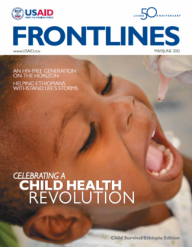

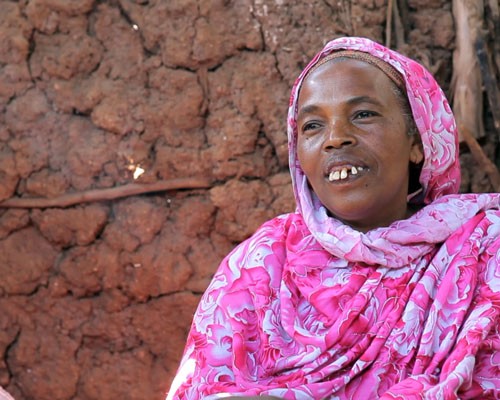
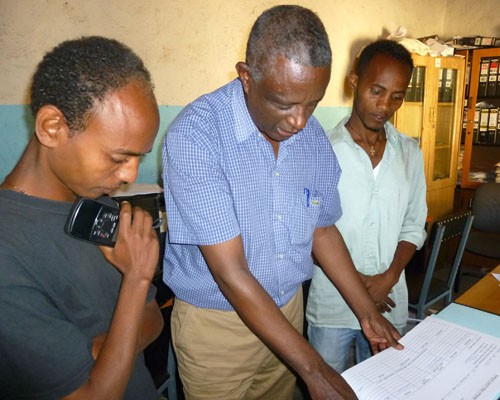
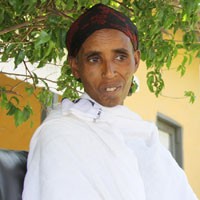
Comment
Make a general inquiry or suggest an improvement.